Top 10 Historical Sites of Iran
Iran is a land of timeless beauty, where the echoes of past empires still resonate through the ages.
Iran's history spans thousands of years, leaving behind a legacy of architectural marvels, soaring monuments, and cultural treasures. From the ancient ruins of Persepolis, famed tombs, majestic palaces and bustling bazaars to stunning places of worship and the intricate tilework of Isfahan's mosques, Iran's historical attractions are a feast for the senses. Join us on a journey through the heart of Persia and discover the top 10 historical wonders where the echoes of the great Persian Empire still ring loud and clear.
Persepolis (Takht-e Jamshid), Shiraz
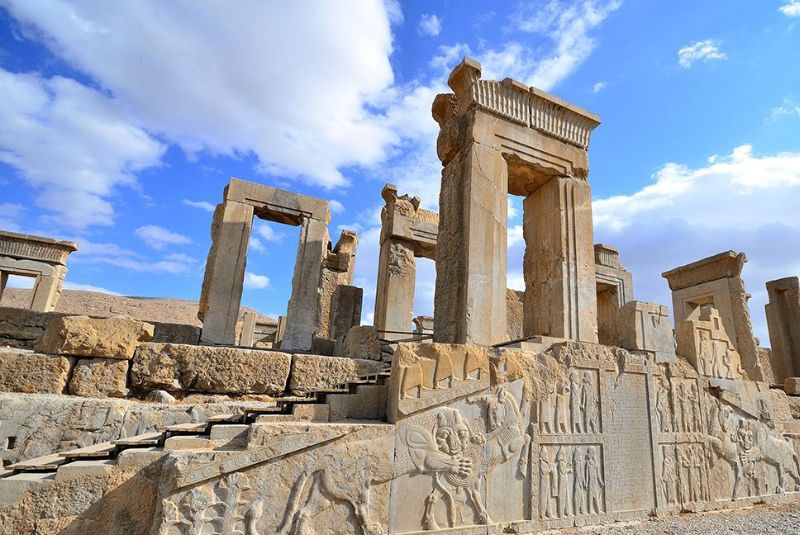
Situated just 50 miles northeast of Shiraz, Persepolis (literally "the city of Persians" in Greek) is a testament to Persian kings' power and sophistication
Persepolis was constructed under Cyrus the Great, Darius I, and was added to by successive kings. It served as the ceremonial capital of the Achaemenid empire in the 5th century BC.
Although the function of Persepolis remains unclear, it was the seat of government for the Achaemenid Empire and a center for the festivals of kings and their empires. Today, Persepolis is a UNESCO world heritage site offering visitors a glimpse into the lives and beliefs of the people who built and inhabited this magnificent city. From the grand audience halls to the humble workers' quarters, visitors can explore the ruins of many ancient buildings, palaces, temples, and monuments, including The Gate of All Nations, Tachara Palace, Hadish Palace, The Council Hall, The Tryplion Hall, Apadana Palace, and The Throne Hall. The intricate carvings and reliefs on the walls and columns are also a feast for the eyes, depicting scenes from Persian mythology, royal processions, and battles.
| Explore the full article: Persepolis; The Great Ancient Persian Capital
Golestan Palace, Tehran
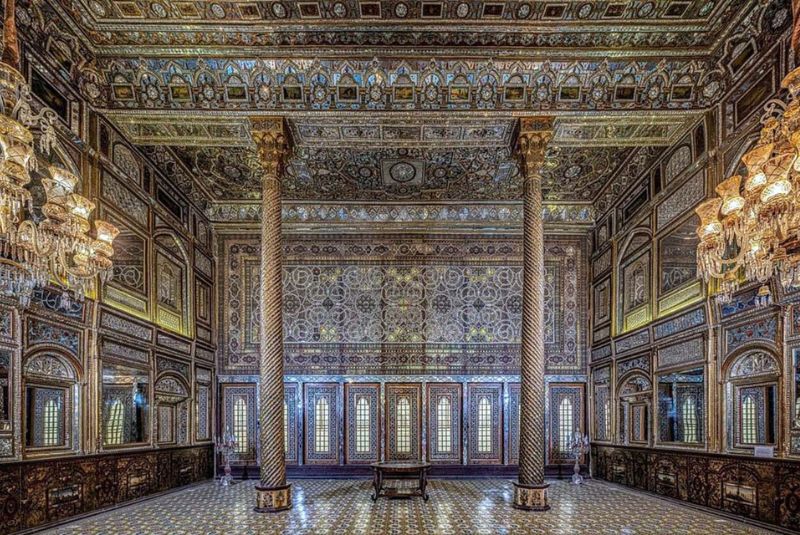
With a history spanning over 440 years, Golestan Palace showcases a variety of historically significant structures that date back to different eras, including the Qajar dynasty.
From the elegant Salam Hall to the enchanting Karim Khan Nook and the dazzling Diamond Hall, every corner of this complex exudes charm and beauty. Marvel at the intricate mirrorwork, stunning gardens, and the masterpieces of painter Kamal ol-Molk, housed throughout the buildings.
This UNESCO heritage site also boasts a photographic archive, a library of manuscripts, and an archive of documents, each providing a glimpse into Iran's rich history and cultural heritage. Don't miss out on visiting some of the most remarkable parts of the palace, such as the marble throne porch, the Mirror Hall, and the brilliant Shams-Al Emarat.
So, come and experience royal life by dressing up as a Qajar prince or princess and snap a photo against the spectacular backdrop of authentic Persian architecture.
Have you ever heard the Golestan Palace Tales?
Discover Now: The History and Tales of Golestan Palace
Nasir-ol-Molk Mosque, Shiraz

The Nasir Al Mulk Mosque, also known as the Pink Mosque, located in the beautiful city of Shiraz, was constructed between 1876 and 1888 by order of Mirza Hassan Ali Khan and designed by Muhammad Hasan-e-Memar and Muhammad Reza Kashi Paz-e-Shirazi.
This historical gem boasts stunning tilework and Muqarnas, making it a one-of-a-kind structure. Its vibrant windows and soaring ceilings create an enchanting play of light and color that's a must-see for every traveler.
Inside, the mosque is filled with dazzling stained glass, painted tiles on the ceiling, and Persian rugs covering the floor that give it a dreamlike quality. The plethora of pink-colored tiles blanketing the ceiling is what earned it the nickname of the Pink Mosque.
The exterior is equally impressive, with an open courtyard and a long, reflecting pool. Visit in the morning when the sun streams through the stained glass, transforming the halls into a dazzling wonderland of rich hues and light play.
| Read the full article: Nasir-ol-molk Mosque, the Magic of Colors
Pasargadae, Shiraz

Located 90 km northeast of Shiraz, this UNESCO World Heritage site in Iran was the first capital of the Achaemenid Empire. It is home to some remarkable examples of Achaemenid art and architecture.
Built by Cyrus the Great, the founder of the Achaemenid Dynasty, Pasargadae boasts two palaces, beautiful gardens, and the famous mausoleum of Cyrus himself. You'll also find a fortified terrace, a royal ensemble of gatehouses, and an audience hall. You can also visit nearby attractions, including the Tall-e Takht fortress and the Tomb of Cyrus the Great.
But what's truly remarkable about Pasargadae is the fusion of different ethnic styles that make up its architecture, making it a culturally diverse archaeological site. The Achaemenid Empire, which extended from the Mediterranean to India, was the first empire to respect and celebrate cultural diversity.
| Discover the complete article: Pasargadae: The Capital City & the Tomb of Cyrus the Great
Naqsh-e Rustam Necropolis, Shiraz
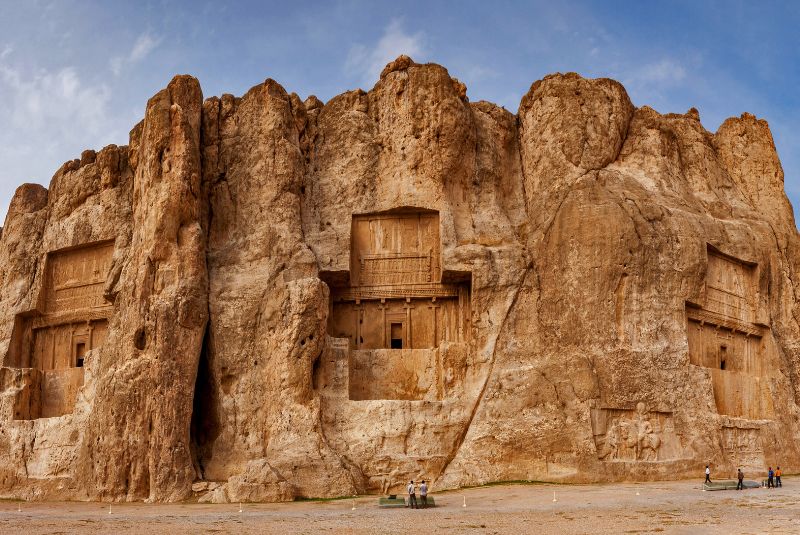
Naqsh-e Rostam is a must-visit ancient attraction in Iran, with four gigantic Achaemenid tombs carved high in the mountain. The whole façade is carved like a palace with four columns and an entrance door. The tombs of Xerxes I, Dariush the Great, Artaxerxes I, and Dariush II are located there. The site also has the largest collection of Sasanid rock reliefs in Iran, with seven reliefs, including the famous victory relief of King Shapour I over Roman emperors. Another mysterious attraction is Ka'ba-ye Zartosht, a 14 m high cube-shaped, windowless building with a Sassanid-era inscription believed to be either a fire temple or the tomb of a king.
| Discover: Isfahan Mosques You Should Visit
Bam Citadel, Kerman
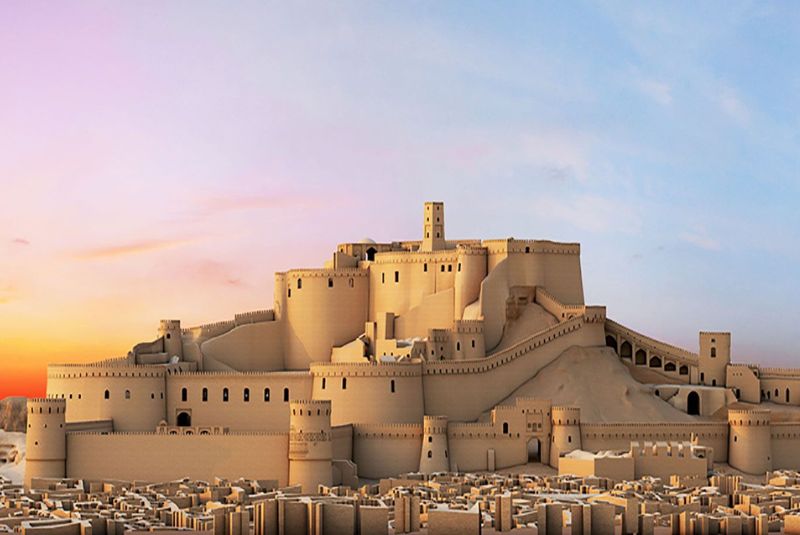
This UNESCO-registered site in southern Kerman province boasts the renowned Arg-e Bam, the largest adobe structure on the planet dating back over 2,000 years to the Parthian Empire, built from sun-dried mud bricks. Once the governor's quarters, this landmark was nearly flattened by a devastating earthquake in 2003, killing over 26,000 people. Witness the incredible reconstruction efforts and marvel at the vast system of qanats, an ancient underground water system still in use today that gives rise to the flourishing dates, a special export of Bam.
| Explore the Magnificence of Persian Citadel: Arg-e Bam
Tower of Silence, Yazd
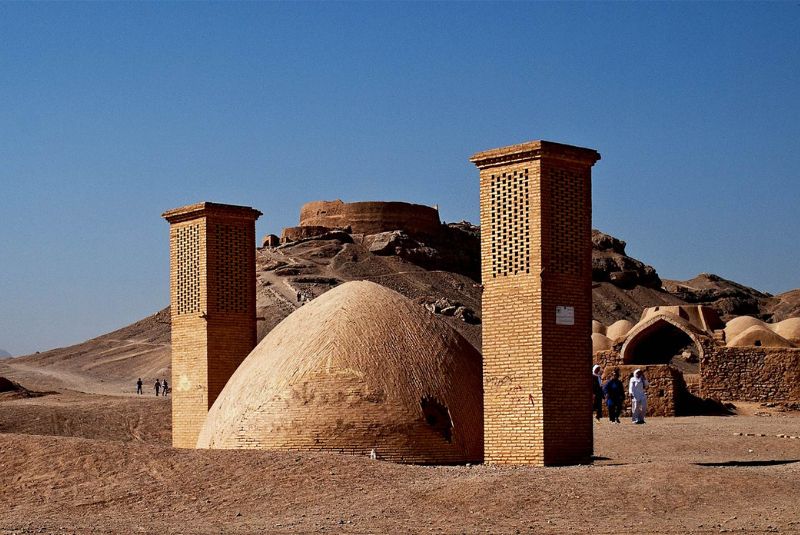
This impressive attraction is one of the largest and most important remnants of ancient Zoroastrianism and offers a glimpse into their unique beliefs. Discover the sacred elements of water, fire, soil, and wind, and learn why they believed the dead should not be buried in the soil. Instead, they built circular towers, like the Tower of Silence, away from their cities, where carnivorous birds would dispose of the corpses. This UNESCO-recognized site is home to two towers, including the 25-meter-high Qajarid-era Golestan Tower and nearby mansions for funeral ceremonies. Witness the ancient rituals of Zoroastrianism at the Fire Temple, where the sacred Atash Bahram has been burning for 1500 years.
| The full article: Towers of Silence & Zoroastrian Burial Culture
Khaju Bridge, Isfahan
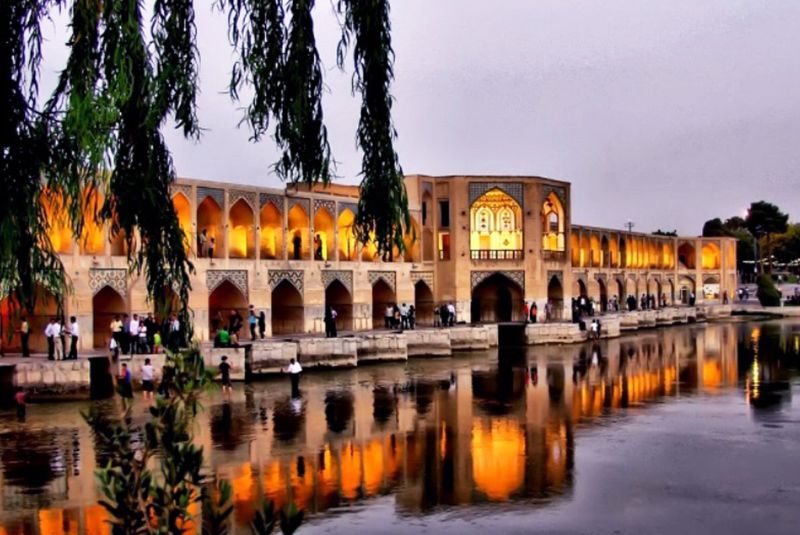
Your trip to Isfahan is not complete without a visit to the Khaju Bridge, one of the most amazing bridges in the world! This stunning arch bridge, built in 1650 under the reign of Shah Abbas II, is an engineering marvel that doubles as a dam and water storage.
Walk across its symmetrical design and experience the reflective symmetry and proportion that make it a masterpiece of Safavid-era architecture. Be enchanted by the intricate tile designs and paintings that adorn the walls and the unique features such as sound absorption arch ceilings and the fascinating "candle" effect. Don't miss the chance to witness the magnificent stone lions, the eagle soaring above the Zayandeh River, and the distinctive structure at the center that served as a temporary palace for the royal family. Join the locals in relaxing by the grassy area, listening to the sound of the water flowing, and enjoying the stunning illumination of the bridge at night.
| Read the full article: Isfahan's Khaju Bridge
Shushtar Historical Hydraulic System
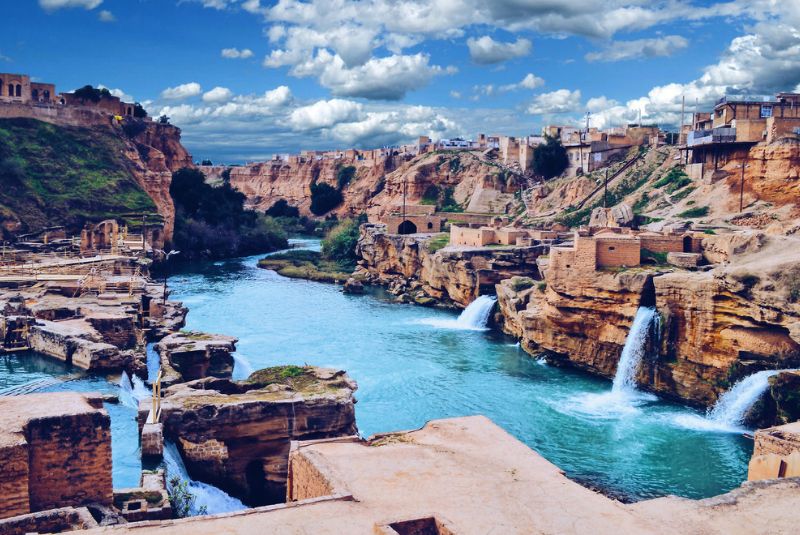
Dating back to the 5th century BC, this masterpiece of creative genius was designed by none other than Darius the Great himself. These ingenious hydraulic systems were built with genius and technical knowledge to make the most of water resources, providing drinking water, irrigation, agriculture, and industry.
Two main diversion canals on the Karun River supply water to Shushtar through a series of tunnels, cascading into basins and flowing onto the surrounding farmland. The system also features bridges, dams, and water mills, showcasing the remarkable knowledge of Mesopotamians and the influence of Roman engineering.
| Read the full guide: Shushtar Historical Hydraulic System
Tabriz Historical Bazaar
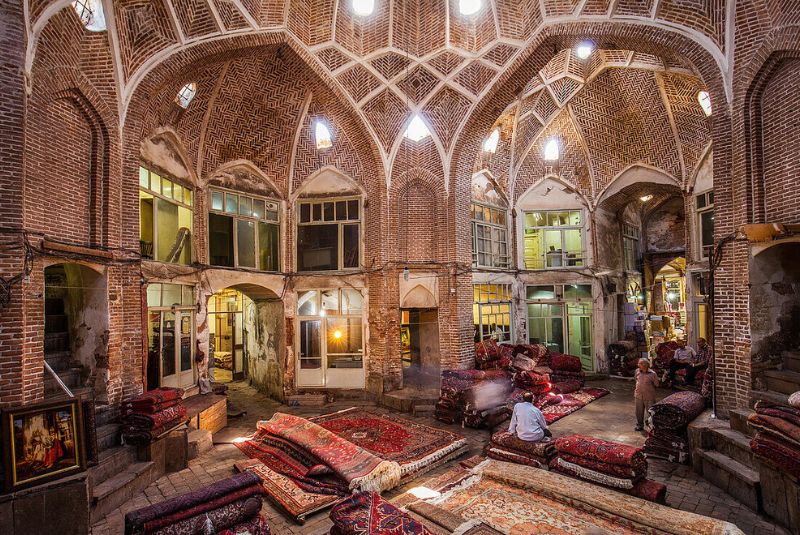
If you travel to Tabriz, make sure to visit the world's biggest roofed Bazaar and one of the oldest bazaars in the Middle East, Tabriz Historical Bazaar.
Dating back to the 10th century and located on the Silk Road, the Tabriz Bazaar has survived earthquakes and renovations to become a UNESCO World Heritage Site in 2010.
The Bazaar is a maze of interconnected red brick buildings, each offering a unique shopping experience. Browse through a variety of products, from gold and jewelry to shoes and household items, and immerse yourself in the lively atmosphere. Don't miss the mesmerizing rug bazaar, where you'll find dyed threads, rug repairs, and stacks of exquisite rugs.
| Read more: Tabriz Bazaar Complex | The Largest Covered Bazaar in Iran
Conclusion
In the heart of Iran, a land steeped in history lies a collection of breathtaking historical sites that whisper stories of empires and civilizations long past. From the magnificent ruins of Persepolis to the enchanting Nasir-ol-Molk Mosque, these top 10 historical wonders paint a vivid picture of Iran's rich cultural heritage.
Each site is a testament to ancient architects' and artisans' ingenuity and creativity. So, let these architectural wonders and cultural treasures ignite your imagination and leave an indelible mark on your soul.
Share your story!
Comment below and let us know about your Experience.
Your story inspires others!


Comment
Leave a Comment